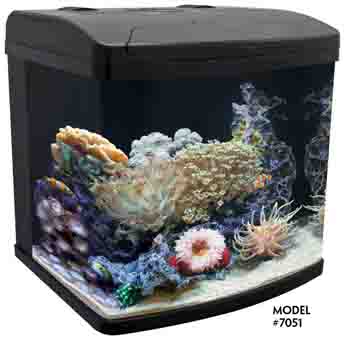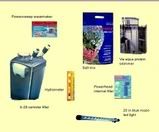Mood:
Now Playing: saltwater, marine aquarium basic setup

This guide is for the beginner saltwater aquarist on how to setup a marine aquarium. The main things to consider when switching from freshwater aquarium to a saltwater aquarium are these, 1)The ocean is consitant in its water quality as in PH, Salinity, Nitrates,Oxygen and mineral content. These things must be maintained in a marine Aquarium. You need a substrate in your aquarium that will release calcium carbonates to maintain a high ph as in the ocean. Crushed coral, oyster shell, and limestone substrates(gravel) are perfect for this. They slowly dissolve in the water to balance the PH and release chemicals that keep the water like the ocean. Next you need a good salt mix to make the freshwater you use similiar to the oceans water. Instant Ocean, Ocean pure, Red SEA, all make salt mixes to do this. The third thing you need is above average filtration and aireation in your saltwater aquarium . You want filters with high flow rates(min 4x the size of the tank) in order to purify the water and break down the ammonia and nitrates. Aireation is important to the aquarium as it oxygenates the water and helps break of gases that are bad for you marine environment. Use canister filters, wet dry units and protein skimmers, plus wave maker powerheads and internal filters to do this.Keep in mind most saltwater fish are caught in the wild and not raised in aquariums and they must have conditions similiar to the ocean. One of the last things to remember is that saltwater fish, corals etc must have lighting similiar to the sun in order to thrive. Buy a good power compact light that duplicates sunlight at a ratio of 3 to 5 watts per gallon, ie 20 gallon tank=60 watts light. Last of all do research on marine aquariums go on forums, find a knowledgeable store to help you and be careful to find out what fish do well , and can cohabitate.

After keeping in mind these facts find a suitable aquarium for your saltwater friends, put crushed coral gravel in (after rinsing or it will cloud), fill the tank 3/4 with water and use chloramine remover at the correct dose, add your marine salt mix at about two cups for ten gallons. Install and acivate your filtration so it is properly working. After about an hour check the salinity with your hydrometer,If below 1023 add salt, if over remove some of the water and add fresh unit it is correct. It will take a while to get the hang of adjusting it.Then install heater, lighting decorations etc and wait about 24 hours and then you can add live sand and or rock and a few small starter fish.
Then decide by getting info on forums etc wheter you want fish, a reef tank and a combination of both.Remember add only a few items at a time until the tanks is at least 2 weeks established.
Update: In setting up your saltwater aquarium live rock is a plus. For reef aquariums you want to purchase at least a half a pound of it per gallon.ie 50 gallon tank=25lbs live rock. You can add a piece at a time to do this or all at once. Please remember that the function of live rock is to establish your saltwater aquarium with good micro organisms that will help keep the toxic waste buildup down in your aquarium Each piece of live rock acts as a mini filter bed for your aquarium. Wait at least 24 hours to make sure your aquarium is at the right salinity(1023 use a hydrometer to test it) and that all the filters are working right and the temperature is correct. Live rock can be bought as uncured or cured rock. If an established aquarium it is better to add cured live rock(It has been in a holding tank 1 to 2 weeks and the dead micro organisms and algae have come off of it) Live rock is collected and shipped dry and may take up to a couple of weeks to reach a store or holding facility so some of it dies off. If setting up a new tank you can use uncured rock, just add to the aquarium, but wait at least 10 days for adding any fish or inverts other than damsels.Your ammonia , and nitrates will goe up as it cures(dying organisms break down into this).The addition of a protein skimmer will speed this along. Skimmers churn the water by either air or injection in a round chamber and cause the dissoved proteins, waste and gases to break off in the collection cup.(A must for tanks with corals, anemones and inverts(reef tank)
Last on the updates for now is this, you can purchase live argonite sand(ocean sand) with the good organisms in it, and use it with your gravel bed and it will fully support aquatic life almost immediately, I set up mike tanks with at least 50%live sand and put fish in immediately. Also you can take live rock or sand out of an existing saltwater aquarium and start your tank right away.
These are specifications everybody wants for the New nano systems, aquariums the Aquapods.Visit our products at.Our ebay store
Nano-Aquarium System
The AquaPod offers all-in-one elegance with a new standard of performance. The modern style compliments and decor and features seamless front rounded glass corners for optimum viewing. The contrast of the black back will highlight the vibrant colors of fish, invertebrates and plants. Hidden under the sleek canopy you'll find a sophisticated lighting system that screams with performance and efficiency - it features two dual color SunPaq compact fluorescent lamps, an internal electronic driving system and Nocturnal Blue Lunar Lights to complete the 24-hour lighting cycle. Combine all of this with our ultra-efficient surface skimming filter and it is quite simply a system we are proud to call AquaPod.
Blistering Lamp Performance
Utilizing industry breakthrough lighting technology from Current gives optimum output and performance. The ultimate lighting spectrum is achieved by utilizing two Dual SunPaq lamps – which combined with the SunPaq driving system produces over 50% more lumen output then comparable systems. Using a proprietary blend of Nichia phosphors, the dual phosphor technology produces eye popping color rendering, while providing the necessary lumen output for high coral growth. Polished German Parabolic Reflector pumps up the light output while a polycarbonate splash lens protects the lamps and ballasts from corrosion.
Densely Packed Power
Independently controlled, internal electronic driving system unleashes the power of the SunPaq lamps while preserving and extending lamp life. The patented circuitry inside each UL-listed ballast ensures consistent high performance and low energy consumption. A high-CFM cooling fan cools the ballast and lamps for peak performance and long life. Strategically placed air vents on the lid allow proper air circulation for optimum cooling.
Night Vision
Nocturnal Blue Lunar Lights cast a mysterious nighttime glow in the tank creating a dark moonlight effect – creating the perfect environment for viewing nocturnal habits and stimulating spawning of your captive inhabitants.
The Underwater Perspective
The seamless rounded front corners provide a panoramic view of your aquatic creatures. The thick high quality glass is bent and seamed with unparalleled precision while the reinforced tank frame provides optimum tank support. All this to provide the perfect viewing portal to your underwater garden.
It Just Skims
The AquaPods efficient internal filter system provides true over-flow skimming unlike traditional integrated filters which only clean water under the surface. No more oil slicks or foam build-up on the waters surface! A mechanical sponge filter keeps out debris and dirt from the main tank while large capacity filter chambers have enough room to keep carbon, phosphate removers, heaters and other filtration gadgets (we’ve got some cool ones coming soon).
What's Included
Each AquaPod includes tank, lighting system, integrated filtration system, submersible pump, mechanical sponge filter, and instructions. Model 7050 includes additional ceramic media, bioballs and activated carbon. Model 7051 & 7052 feature an adjustable weir overflow filtration system.
AQUAPOD SPECIFICATIONS
Model
Volume (gallons)
Lighting Specifications
Lunar Lights
Cooling Fan
Independent Control
Pump Capacity (gph)
Inside Tank Dimensions
Overall Dimensions
Weight
7050
12
1x27w SunPaq Dual Daylight & 1 27w SunPaq Dual Actinic
2 Nocturnal Blue
Yes
Yes
160 gph
16.5"x12"x13.75"
16.5"x15"x16.5"
40 lbs.
7051
24
1x32w SunPaq Dual Daylight & 1x32w SunPaq Dual Actinic
2 Nocturnal Blue
Yes
Yes
290 gph
19.75"x13"x17.5"
19.75"x17"x20"
50 lbs.
7052
24
1x70w 14,000K PowerPaq HQI
6 Nocturnal Blue & 6 Moon White
Yes
Yes
290 gph
19.75"x17"x20"
19.75"x17"x22"
60 lbs.
AQUAPOD ACCESSORIES
Model
Description
Dimensions
Weight
7054
Stand for Aquapod 12-gallon
16.5" x 15" x 28"
10 lbs.
7053
Stand for Aquapod 24-gallon
19.75" x 17" x 28"
12 lbs.
CONFIGURATIONS
MODEL #7051
HOME|SUPPORT|CONTACT|PRODUCT REGISTRATION|IMPORTANT SAFETY INFORMATION
?2005 Current Inc. | Updated: 2006-03-06 19:09:42
Posted by anime6/markq
at 12:53 PM PDT
Updated: Monday, 1 January 2007 1:25 PM PST
Post Comment | Permalink | Share This Post
Updated: Monday, 1 January 2007 1:25 PM PST
Post Comment | Permalink | Share This Post



